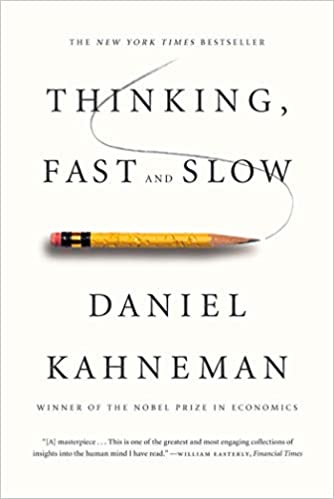There’s a lot riding on a CEO. If the average adult makes about 35,000 decisions per day, imagine how many decisions a CEO has to make, with an entire company depending on their good judgment! As a result, they’ve had to develop some brilliant ways to ensure they always choose correctly.

Thinking Fast and Slow
by Daniel Kahneman
⏱ 12 minutes reading time
🎧 Audio version available
Have a Devil’s Advocate
A great CEO knows that no one person can possibly see every angle, every time. That’s why appointing someone to propose a contentious opinion is a common technique the best use.
A devil’s advocate is someone who expresses an opposing opinion in order to A) provoke further debate and B) test the strength of the decision in question. Assigning a devil’s advocate on your team can actually make discussions more efficient. It also helps identify any weaknesses. Which sounds more convincing? Having someone on your team point out possible contingencies before they actually take place or discovering them after it’s too late?
Stop Reacting
A lot of people go through life merely reacting to situations. In business, or when trying to lead a business, simply reacting can’t cut it when it comes to making vital decisions that affect your company and the people working for you.
A talented CEO eventually learns– whether that’s through trial and error or through being warned firsthand– that there’s a difference between reacting and making a decision in the spur of the moment versus making a decision based on a gut feeling, though that’s something we’ll touch on later.
So, instead of reacting when someone comes to them with an alarming issue or an operational problem, what do high-performing CEOs do? If they don’t have a plan, they sit back and think.
Example? Take Elon Musk, who figured out a way that’s “really helpful for figuring out the tricky things.” His trick involves six simple steps.
Number one is asking a question.
Number two is gather as much evidence about the decision as he can.
Number three is developing axioms, which are statements accepted as true as the basis for argument or inference, and then assigning a probability of truth to each of them.
The fourth step is reaching a conclusion based on cogency– the quality of being logical– and determining whether these axioms are true, their relevance, if they lead to the conclusion, and with what probability.
Once that’s done, Elon Musk likes to find a devil’s advocate to disprove the conclusion he just reached. At this step, he asks others to break down his conclusion.
If no one can break down the conclusion or invalidate it, he goes with the decision. Now, he can say that the decision was strategic, driven by data, and is protected against possible outcomes.
Balance Risk and Reward
There’s always going to be some sort of risk involved– that’s true in both business and real-life decisions. That’s why it’s important to balance taking risks and measuring the rewards you could reap.
Think about it. The majority of CEOs regret the decisions they didn’t make the most– or they regret the decision that they made too soon or too late. And that’s why most CEOs prefer using risk-aversive strategies. But then this happens, the company is kept in a static state. Rather than making headway towards the next goal, the company may instead fall behind.
Taking calculated, strategic risks is the way to go– at least according to Anne Mulchay, the chairman and former CEO of Xerox, who says being too risk-averse and too analytically driven held them back. Mulcahy added that, by the time they reached a decision, someone else had beaten them to it.
Make Fewer Decisions!
Is that true? Making fewer decisions leads you to make better decisions? Yes! Just ask Mark Zuckerberg or Steve Jobs– or even former President Barack Obama. All these successful figures share that they nitpicked every decision they were set to make and delegated what they could.
If you’ve seen Zuckerberg’s iconic t-shirt and jeans combo– or Jobs’ indelible black turtlenecks, then you’ve already seen how they implement this strategy. This strategy keeps them from wasting time and effort that should be conserved for more important choices.
Delegate
Speaking of making fewer decisions, you’ll find that the best CEOs aren’t afraid to delegate. CEOs feel the need to be responsible for every single decision for the company, but where does that lead? It’s a one-way ticket to experiencing what’s known as “decision fatigue.”
Decision fatigue is when you get too burnt out to make sound and effective decisions. So, you’re actually headed the wrong way when it comes to making the best decisions and are therefore, more likely to make poor choices.
Think of your mind as a reservoir, with a limited number of decisions you can use. The more you draw from it, drain it, the harder it is to have the best, most beneficial, and most rational line of thinking.
That’s where your trusted team comes in. Find someone you trust who has the experience and authority necessary to aid you. You’ll find that your business will thrive as it’s filled with a well-rounded team of talented, fulfilled employees who can make valuable decisions.
Always Say the “What” and the “Why”
Whenever you make a decision surrounded by your team of employees or stakeholders, it’s always important to know the answer to all the “why” and “what” questions they may have. This means you– and by extension, your team– need to further understand why you should go with a choice or not.
The opposite option is not communicating your point of view, which leads to teams finding it more difficult to support and execute what you told them.
Always Be One Step Ahead
What does being one step ahead entail? It’s easier than you think! If you’re one step ahead, you will find you rarely fumble or are unsure.
That means that you know everything there is to know about the competition, for example. You’ll never make the best decisions for your company if you have no idea what curveballs may be thrown at you in the market.
Being a step ahead means always looking forward to the future– and not only that, but planning for growth. It means staying on top of whatever developments are happening in your industry, following consumer trends, and not being afraid to invest in new methods and technology.
Be Confident, Honest, and Humble
According to Mark Fukunaga, the CEO of Servco, confidence, honesty, and humility are what you need in order to be a great decision-maker.
He breaks it down like this: confidence is what pushes you to not being afraid of taking risks and helps you handle uncertainty.
He picked honesty– honesty with yourself– because self-doubt isn’t one of the traits a CEO should have. Fukunaga calls it self-deception, and says it’s a CEO’s “biggest enemy.”
Finally, humility keeps you grounded. He also says it’s to avoid becoming too invested in an idea. That means being ready to drop an idea and picking another when you realize it’s the better choice.
Let Go of Small Fumbles
So you dropped the ball once, so what? Name one CEO who hasn’t. I bet you can’t. Everyone makes mistakes. Expecting to be the exception can lead to either excessive self-doubt or arrogance– both will drive you crazy.
Instead of dwelling on the past, if you make an error, own up to that mistake, take responsibility for it, and learn from it. Now, the next decision you make is automatically a better one because you have more experience.
Simplify
One of the top simple tricks high-performing CEOs use is literally the title: simplify.
Instead of looking at an issue as a “complicated problem,” realize there is only “complicated thinking.”
Yes, there’s a big decision ahead. So simplify it as much as you can. Lay down the steps, your goal, the potential outcomes, et cetera. When you have all the parts laid out in front of you, decisions become easier.
Stick To Your Gut
Amazon CEO, Jeff Bezos, has decisions broken down into Type 1 and Type 2. To quote his newsletter, Type 1 decisions are
“consequential and irreversible or nearly irreversible – one-way doors – and these decisions must be made methodically.”
However, he admits that Type 2 decisions, which are “changeable, reversible – two-way doors” and that they “should be made quickly by high judgment individuals or small groups.”
So, if the world’s richest man agrees you need good judgment to make decisions, even if they’re reversible, you must see the truth in his words.
Decisions are going to come your way– and you may not have data to fall back on or even have time to analyze the best outcome. That’s why you should trust your gut. There’s a reason why you are the CEO. A gut feeling is an instinct you’ve honed over the years. It’s based on countless experiences. And it is the reason why you make the best judgments you can based on the limited information you have at the moment.
What Is Snapreads?

With the Snapreads app, you get the key insights from the best nonfiction books in minutes, not hours or days. Our experts transform these books into quick, memorable, easy-to-understand insights you can read when you have the time or listen to them on the go.


